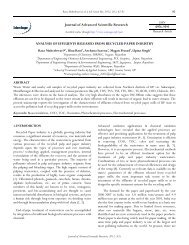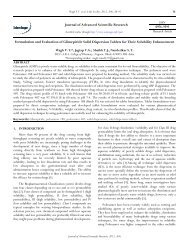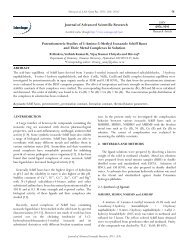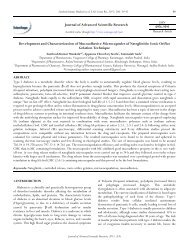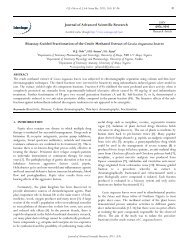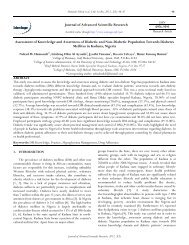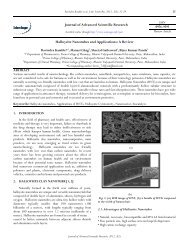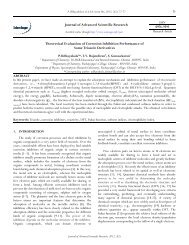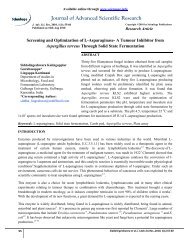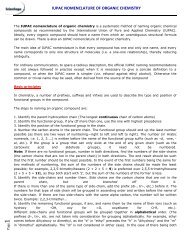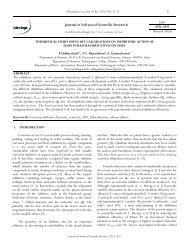Density Functional Theory Investigations for the ... - Sciensage.info
Density Functional Theory Investigations for the ... - Sciensage.info
Density Functional Theory Investigations for the ... - Sciensage.info
Create successful ePaper yourself
Turn your PDF publications into a flip-book with our unique Google optimized e-Paper software.
() r N<br />
s( r) f ( r)<br />
S<br />
N<br />
vr ( ) vr ( )<br />
P. Udhayakala et al, J Adv Sci Res, 2012, 3(3): 67-74 70<br />
(12)<br />
From this relation, one can infer that local softness and<br />
Fukui function are closely related, and <strong>the</strong>y should play an<br />
important role in <strong>the</strong> field of chemical reactivity.<br />
According to <strong>the</strong> simple charge transfer model <strong>for</strong> donation<br />
and back-donation of charges proposed recently by Gomez et<br />
al.,[44] an electronic back-donation process might be occurring<br />
governing <strong>the</strong> interaction between <strong>the</strong> inhibitor molecule and<br />
<strong>the</strong> metal surface. The concept establishes that if both<br />
processes occur, namely charge transfer to <strong>the</strong> molecule and<br />
back-donation from <strong>the</strong> molecule, <strong>the</strong> energy change is directly<br />
proportional to <strong>the</strong> hardness of <strong>the</strong> molecule, as indicated in<br />
<strong>the</strong> following expression.<br />
ΔE Back-donation<br />
4<br />
(13)<br />
The ΔE Back-donation implies that when η > 0 and ΔE Back-donation<br />
<br />
Inh-I, which implies that <strong>the</strong> molecule which has <strong>the</strong> highest<br />
tendency to donate electrons is Inh-II. This is in agreement<br />
with <strong>the</strong> experimentally determined inhibition efficiency.<br />
Table 2. Quantum chemical descriptors <strong>for</strong> Inh-I and Inh-II<br />
calculated using B3LYP/6-31G (d,p).<br />
The inhibition effect of inhibitor compound is usually<br />
ascribed to adsorption of <strong>the</strong> molecule on metal surface. There<br />
can be physical adsorption (physisorption) and chemical<br />
adsorption (chemisorption) depending on <strong>the</strong> adsorption<br />
strength. When chemisorption takes place, one of <strong>the</strong> reacting<br />
species acts as an electron pair donor and <strong>the</strong> o<strong>the</strong>r one act as<br />
an electron pair acceptor. The energy of <strong>the</strong> highest occupied<br />
molecular orbital (E HOMO ) measures <strong>the</strong> tendency towards <strong>the</strong><br />
donation of electron by a molecule [45].<br />
High values of E HOMO have a tendency of <strong>the</strong> molecule to donate<br />
electrons to appropriate acceptor molecules with low energy,<br />
empty molecular orbital. Increasing values of E HOMO facilitate<br />
adsorption and <strong>the</strong>re<strong>for</strong>e enhance <strong>the</strong> inhibition efficiency, by<br />
influencing <strong>the</strong> transport process through <strong>the</strong> adsorbed layer.<br />
There<strong>for</strong>e, higher values of E HOMO indicate better tendency<br />
towards <strong>the</strong> donation of electron, enhancing <strong>the</strong> adsorption of<br />
<strong>the</strong> inhibitor on mild steel and <strong>the</strong>re<strong>for</strong>e better inhibition<br />
efficiency. E LUMO indicates <strong>the</strong> ability of <strong>the</strong> molecule to accept<br />
electrons. The binding ability of <strong>the</strong> inhibitor to <strong>the</strong> metal<br />
Parameters Inh-I Inh-II<br />
Ionization potential (I) /(eV) 5.9227 5.5341<br />
Electron affinity (A) /(eV) 1.4801 1.2313<br />
Global Hardness(η) / eV 2.2213 2.1514<br />
Electronegativity( χ) (eV 3.7014 3.3827<br />
Electrophilicity ( ω) 3.08386 2.6593<br />
Chemical Potential (μ ) -3.7014 -3.3827<br />
Global softness(S) 0.450186 0.464813<br />
Energy gap (ΔE) is an important parameter as a function of<br />
reactivity of <strong>the</strong> inhibitor molecule towards <strong>the</strong> adsorption on<br />
<strong>the</strong> metallic surface. As ΔE decreases, <strong>the</strong> reactivity of <strong>the</strong><br />
molecule increases leading to increase in <strong>the</strong> %IE of <strong>the</strong><br />
molecule. Lower values of <strong>the</strong> energy difference will render<br />
good inhibition efficiency, because <strong>the</strong> energy to remove an<br />
electron from <strong>the</strong> last occupied orbital will be low [48]. A<br />
molecule with a low energy gap is more polarizable and is<br />
generally associated with <strong>the</strong> high chemical activity and low<br />
kinetic stability and is termed soft molecule [49]. In our study,<br />
Journal of Advanced Scientific Research, 2012, 3(3)



